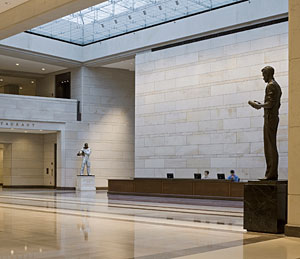I’m baffled by people who dismiss whole categories of things. Two decades ago, I was summoned to the office of House & Garden’s new editor in chief, Anna Wintour, and saw my dumbfounded expression reflected in her sunglasses as she declared, “I don’t like adjectives. You use too many adjectives. That’s all.” How can you eliminate a major part of speech, I wondered? Did she realize that her ultimate accolade — “It’s so modern” — is one-third adjective? But now I confess complete antipathy to an entire building type: the visitor center.


Additions to accommodate ticketing, tour groups, and interpretive displays have become commonplace at landmarks of all kinds. But leave it to our federal government’s legislative branch — profoundly corrupt and pathologically self-indulgent — to max out the genre. The opening, in December, of the Capitol Visitor Center in Washington, D.C., went nearly unnoticed by the press, which was just as well for anyone implicated in a star-spangled boondoggle worthy of The Guinness Book of Pork.
When construction of the labyrinthine subterranean annex beneath East Capitol Plaza began, in 2002, no one could have predicted an accident of timing that would put this extravaganza of excess in an unexpected context when the job was finally completed, six years later. Several weeks before the facility’s low-key debut, an overwhelming economic crisis compelled Congress to pass a $700 billion bailout package, compared to which the Capitol Visitor Center’s flabbergasting tab of $621 million, double the original estimate, suddenly looked like chump change — though that’s about $200 million more than Yoshio Taniguchi’s MoMA renovation and expansion (which opened in 2004).
This 580,000-square-foot finished basement — three fourths the size of the Capitol itself—supersedes its principal functions as tourist-processing machine and exhibition hall in several unstated ways. It is also an embodiment of the profligate but ineffectual regime that commissioned it; a reductio ad absurdum of prevalent notions that historic sites require a panoply of “amenities” to entice, engage, entertain, enlighten, and enlarge its audience; and a manifestation of the “grow-or-die” corporate philosophy increasingly embraced by cultural, educational, and philanthropic institutions in thrall to their plutocratic backers.
Such alternative interpretations offer cautionary civics lessons quite different from the panegyrics of politicians who promoted what might be dubbed “the Freedom Showroom.”
This combination entry lobby, security checkpoint, history gallery, and food-service complex was designed beyond an inch of its life by RTKL and overseen by the Office of the Architect of the Capitol, the in-house congressional construction agency headed during most of this project by Alan M. Hantman, FAIA, who retired in 2007.
The massive initiative was not prompted by the 9/11 terror attacks, as might have been expected, but rather by the shooting deaths of two Capitol policemen in 1998. Forget their being memorialized by stricter gun controls enacted by a Congress in the pocket of the NRA. The obvious solution to that tragedy was to dig deep and create an insanely expensive, oppressively scaled, marble-armored bunker to keep lawmakers and lobbyists out of firearm range. The result is an eerie, meta-Classical netherworld that makes Pei Cobb Freed’s airportlike Grand Louvre (1989) appear humane and understated.
Although the Capitol Visitor Center purports to ease public access to our nation’s seat of government, it does exactly the opposite, and thereby turns mere architectural wrongheadedness into something more sinister and alarming. The inherent problem with all visitor centers has never been more clearly exposed than it is here. The citizenry’s ability to roam around the halls of Congress is a thing of the past, and henceforth most people’s experience of the Capitol will be confined to the new underground annex. Its hermetic atmosphere — symptomatic of all below-grade interiors — is relieved only by skylights, one of which frames a foreshortened vignette of Thomas U. Walter’s white-painted cast-iron dome (1863). From this disorienting worm’s-eye perspective, the looming cupola brings to mind a superscale souvenir snow globe.


Post a comment to this article
Report Abusive Comment